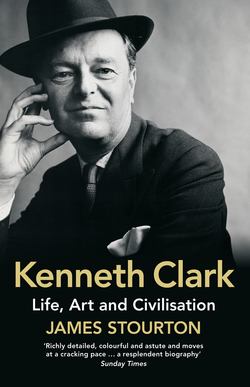Читать книгу Kenneth Clark: Life, Art and Civilisation - James Stourton, James Stourton - Страница 6
Foreword
ОглавлениеIn his memoirs Kenneth Clark complained that Harold Nicolson ‘could not resist shampooing’ his account of a dinner party, and added the warning that ‘the historian who uses “original documents” must have a built in lie-detector’.1 This is equally true of published material. Clark’s own two volumes of memoirs are exceptionally entertaining, and are both friend and foe to the biographer. Friend, because they cover most of Clark’s life and tell his story more beautifully than any biographer ever could; foe, because Clark wrote them mainly from memory, which was not always reliable – and sometimes verged on the mytho-poetic. Every event needs to be checked against alternative sources; the chronology is loose, and Clark occasionally puts himself at events at which he was demonstrably not present. This was not deliberate on his part, but simply due to the passage of time. The memoirs tell many good stories, although I have reproduced only a tiny handful of them, as they are usually about other people. Since Clark’s own voice is always eloquent I quote him whenever possible; where he has written an alternative and usually earlier account of an event, I have used this for a fresh perspective. An example is the manuscript containing fragments of an art-historical autobiography that he wrote at the end of his life, Aesthete’s Progress, now in his publisher John Murray’s London archive.
Clark did have an eye to history; he kept all his letters to his parents, and rarely threw anything out, even occasionally annotating documents in his own archives. The Clark Archive held at Tate Britain is of a daunting scale, with thousands of letters and documents full of biographical treasures. Clark, however, offered a second warning to a would-be biographer: ‘One realises how little the historian, who must rely on letters and similar documents, can convey a personality. So much depends on the accident of whether or not a character can get himself into his letters.’2 Clark had a famous dislike of both receiving and writing letters, and whenever he could he would dictate them to an assistant. He was too busy to put art into them, but even the briefest will contain a striking phrase; he was incapable of writing a dull sentence. The majority of the letters quoted here are from carbon copies retained by Clark’s various assistants for reference. I have altered Clark’s pervasive use of ampersand to ‘and’, for reasons of flow. Quotations from the Berenson–Clark letters are taken from the excellent Yale edition edited by Robert Cumming.
For the second half of Kenneth Clark’s life we have the astonishing series of letters that he wrote to Janet Stone, which provide a vivid self-portrait, and offer a depth and nuance hitherto unavailable. In these letters his true unbuttoned character is displayed – they were a safety valve, just as a diary was to Pepys or a wartime journal to Lord Alanbrooke. It is tempting to compare these letters to his son Alan’s diaries, but their motivation – beyond the love of writing – was different. The letters to Janet Stone are held at the Bodleian Library in Oxford under a thirty-year moratorium (for reasons explained here). Fortunately, when Dr Fram Dinshaw of St Catherine’s College, Oxford, was appointed to be the original authorised biographer of Kenneth Clark in the 1980s, he was given permission by Janet Stone to read them. All the Stone letters I quote are from Dr Dinshaw’s selected transcriptions.
The biographer of Kenneth Clark is fortunate that both his sons, Alan and Colin, left behind such compelling accounts of their parents. I was equally fortunate in having his daughter Colette, and daughter-in-law Jane, ready to answer questions, and I put it on record that neither of them has at any time attempted to alter anything I have written apart from correcting factual errors. I am lucky to have known some of the main players in the story, John and Myfanwy Piper and Reynolds and Janet Stone, which makes it easier to understand why Clark found them so attractive, and their houses such blessed plots. Virtually all the crew of Civilisation are alive and were able to give me interviews except for Michael Gill, who I met before his death, but alas before I knew I would be so concerned with his story. Perhaps the greatest surprise of all was to find Clark’s favourite television producer from his ATV days in the late 1950s and early 1960s, Michael Redington, not only alive and well but living just three streets away from me in Westminster.
A word on nomenclature: Clark was always known as ‘K’ by family and friends. In 1938 he became Sir Kenneth Clark, and in 1969 he was given a peerage and became Lord Clark of Saltwood – but I refer to him throughout as ‘Clark’.
Clark studies will continue to produce new interpretations and information. This work must be seen as ‘notes towards a definition’ – space restricted me on nearly every subject covered – and it should be taken as an encouragement to other scholars to investigate his life and achievements further.
JAMES STOURTON
London, 2016
